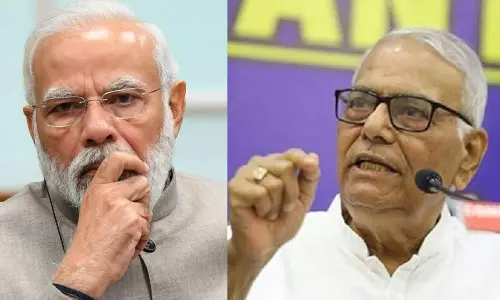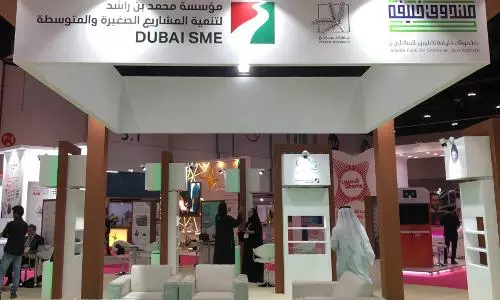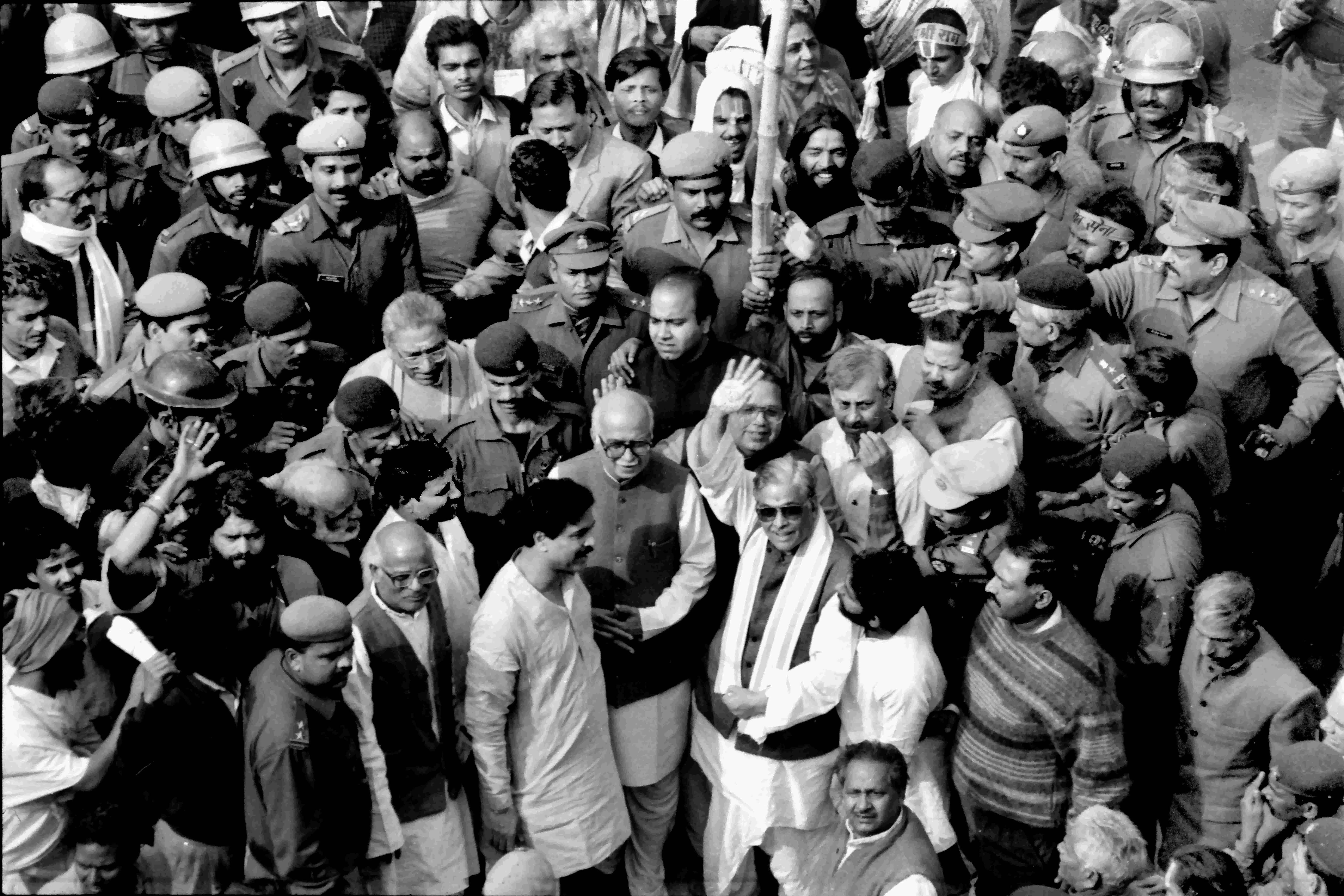
Babri Masjid demolition: from the Commission to the Court
text_fieldsMaking a mockery of the judicial system, a special CBI court in Lucknow today acquitted all 32 prominent BJP/VHP leaders of criminal conspiracy charges in the Babri Masjid demolition case, citing lack of evidence. Ironically, this flies in the face of a judicial commission of enquiry, which prepared a 1000 page tome over a period of 17 years, to establish the criminal conspiracy charges against these very leaders.
December 6, 1992 was a day when all pretence of rule of law, abiding by the Constitution and upholding the sanctity of institutions, had been thrown to the winds. Thousands of manic kar sevaks roared " ek dhakka aur do, babri masjid tod do," (just give one push and bring down the mosque) even as a handful of them clamboured atop the dome of Babri masjid on December 6, 1992, frantically hammering away at the structure. And in no time, with a loud bang, a huge cloud of dust soared above everyone, as the first dome came crashing down around noon on that fateful day. With visibility almost nil due to the dust cloud, one could see mobs clambering up the other two domes too even as roars of jai sriram rent the air. In between, flashed the picture of a jubilant Uma Bharti, hugging a beaming Murli Manohar Joshi on the dais, even as LK Advani feebly tried telling the mob to stop doing whatever they were upto. The UP policemen, on specific instructions of the then chief minister Kalyan Singh, simply stood by, just watching the spectacle. Not only this, the local police had blocked all entry roads to the site, ostensibly to prevent crowds from reaching the action, but also to prevent the waiting central paramilitary forces from reaching the spot. Within a span of a few hours, the three domes of Babri masjid had been flattened. Any journalist who was trying to either take pictures or record the events, had been beaten up and chased away so that no evidence was left for posterity, of the meticulously planned operation.
Today, 28 years after the fateful day, a special CBI court which was looking into the circumstances leading to the demolition of the mosque, found nothing criminal or conspiratorial or pre-planned in the act. It acquitted all 32 prominent BJP/VHP leaders named in the conspiracy for lack of evidence.
The court ruled that the demolition of Babri masjid in Ayodhya on December 6, 1992, was not planned and the structure was brought down by "anti-social elements. " It acquitted all 32 accused including BJP leaders LK Advani, Murli Manohar Joshi, Uma Bharti and Kalyan Singh of conspiracy charges in the landmark verdict. "The accused tried to stop the demolition," special CBI judge SK Yadav ruled, adding that the Hindu activists who tore down the 16th-century mosque were "anti-social elements". Interestingly, the special judge, who failed to see any conspiracy or planning in the wanton destruction of the mosque, had been given an extension of service to deliver this verdict. The judge also said the audio and video evidence produced by the CBI did not establish conspiracy charges. "The audio of the speeches was also not clear," he said.
But the travesty of justice which unfolded today was almost expected because on November 9, last year, the Supreme Court had handed over the entire site to Hindus, overlooking the claims of Muslims, to build a Ram Temple there. The ground-breaking ceremony of the temple was performed in August this year by none other than the prime minister himself. The Supreme Court had only perfunctorily mentioned the demolition, calling it "unlawful destruction". While granting Muslims an alternative site to build another mosque in Ayodhya, the apex court had said Muslims had been wrongly deprived of a mosque that was constructed well over 400 years ago. So "it is necessary to provide restitution to the Muslim community for the unlawful destruction of their place of worship"
But the mockery of justice could not have been more stark because the Liberhan commission of enquiry which was constituted by the then Congress government to look into the circumstances leading to the demolition of the mosque, had unambiguously held a number of prominent BJP/VHP leaders responsible for the crime. This included L K Advani, MM Joshi, Uma Bharati and the then UP chief minister Kalyan Singh.
The Justice Liberhan Commission, which took an excruciating 17 years to complete the enquiry, had examined 100 witnesses before submitting its report to the government in June 2009. The Liberhan report had held 68 individuals, including BJP stalwarts LK Advani, MM Joshi, Uma Bharti, Kalyan Singh, and Lalji Tandon and former prime minister Atal Bihari Vajpayee, Shiv Sena leader Bal Thackeray, VHP leaders Ashok Singhal, Vinay Katiyar and Sadhvi Rithambhara, among others, "guilty of inciting communal discord" ahead of the destruction of the Babri Masjid. Though not all 68 people held 'guilty' by the Liberhan commission were named as accused in the demolition trial, L K Advani, M M Joshi, Kalyan Singh, Uma Bharti and Vinay Katiyar were among those charged in the case by the CBI for criminal conspiracy and making incendiary speeches. All of them have now been acquitted by the special CBI court.
The Liberhan Commission report had minced no words in indicting senior leaders of the Bharatiya Janata Party (BJP) — from former prime minister Atal Bihari Vajpayee to Kalyan Singh, the then chief minister of Uttar Pradesh — along with the Rashtriya Swayamsevak Sangh (RSS), the Vishva Hindu Parishad (VHP), the Bajrang Dal, and the Shiv Sena.
"The demolition… took place in the presence of national and local leadership," wrote Liberhan in his 998-page report. "Cadres of the RSS, Bajrang Dal, VHP, BJP and Shiv Sena along with their leaders were present at the spot. They either actively or passively supported the demolition."
Liberhan said a deeply-rooted nexus of state authorities was complicit in encouraging the violence that claimed hundreds of lives. The Commission did not spare the then Narasimha Rao government either, saying the delayed action of the Centre further compounded the situation. The demolition, it noted, "reduced one of the oldest civilisations to a state of stark intolerance and barbarianism — all for petty political gains". Saying the perpetrators were "vying for the fame of blowing up the structure" and the desire for complete "political power", the report drew the inference that the agitation for the construction of a Ram temple at the site was a "non-event" that took the tones of a "movement" only once the BJP joined the fray.
The report squarely held a "handful of malevolent leaders" masquerading as "moderate elements in the Sangh Parivar" responsible for invoking the name of Ram to turn tolerant peaceful communities into "intolerant hordes". "It cannot be assumed even for a moment that (BJP patriarch) LK Advani, AB Vajpayee or (veteran BJP leader) Murli Manohar Joshi did not know the designs of the Sangh Parivar," read the report.
"The BJP was therefore an essential ingredient in the Parivar smorgasbord and essential to capture de jure power and authority, in furtherance of its goal of establishing a Hindu Rashtra," it added.
Commenting on the role of prominent BJP leaders, the commission noted that the VHP kicked off its 'Ram Janmabhoomi Mukti Andolan' after a meeting Vajpayee and Advani, along with leaders of the RSS and the VHP, had with Narasimha Rao in the days before the demolition.
Vajpayee, according to the report, said in Delhi, "We are not against Muslims or opposed to them but with respect to the reconstruction of the temple, we will not compromise with anybody."
LK Advani, according to the Liberhan commission report, was the driving force of the demolition. From mobilising support for the cause through his rath yatra to making several incendiary speeches, the Liberhan panel noted that Advani "infused life into the issue". As the crowd pushed ahead on 6 December, Advani and Uma Bharti, among others, reportedly appealed for restraint, visuals of which have been cited by the special judge to acquit them. But the commission had questioned whether these attempts were for the benefit of media or genuine appeals.
Holding Advani squarely responsible for the demolition, the commission noted that Advani's 1990 rath yatra gave an impetus to the Ram Janmabhoomi movement. "It brought the BJP and its allies to power in many states in 1991," it added.
Murli manohar Joshi, who served as the BJP president between 1991 and 1993, added strength to the process of mobilisation and the participation of the government and the state or the political executive for the mobilisation carried out continuously, at least since 1989, the report added. The report noted that Joshi, along with the then UP chief minister Kalyan Singh, had visited Ayodhya to pay obeisance at the controversial site in July 1991, where slogans like "Ram lalla hum aayein hain, mandir yahin banayenge (Ram lalla, we have come, will build the temple right here)" were raised. According to the commission, they took an oath to construct the Ram temple at the site, along with the people present there.
Kalyan Singh, who as UP chief minister presided over the demolition, assumed office in 1991, and his government went on to acquire 2.77-acre Ram Janmabhoomi-Babri masjid complex. The failure of his state administration to prevent the demolition, and alleged complicity in the sequence of events, are central to the Liberhan report.
The report noted that Singh transferred officers who were not in favour of the move. According to the commission, 90 per cent of the police personnel deployed to protect the Babri masjid were sangh parivar sympathisers, and the rest under strict orders not to use force against kar sevaks.
"The chief minister was the pivotal figure and played the key role in the whole episode of demolition and the temple construction movement," the Liberhan commission added.
"Kalyan Singh, his ministers and his handpicked bureaucrats created… cataclysmic circumstances which could result in no consequences other than the demolition of the disputed structure and broadened the cleavage between the two religious communities resulting in massacres all over the country," it noted. "They… willfully enabled and facilitated the wanton destruction and ensuing anarchy," the report noted.
The Commission concluded that the factual matrix of the case yields "indisputable evidence that lured by the prospect of power or wealth, a rank of leaders emerged within the BJP, RSS, VHP, Shiv Sena, Bajrang Dal etc. who were neither guided by any ideology nor imbued with any dogma nor restrained by any moral trepidation".
To sum up, December 6, 1992 saw a state of Uttar Pradesh unwilling and unable to uphold the majesty of the law. The ennui flowed from the very office of the Chief Minister (Kalyan Singh) downwards and infected the state's minions down till the bottom.
"The state had become a willing ally and co-conspirator in the joint common enterprise to announce the revival of a rabid breed of Hindutva, by demolishing the structure they had denounced as a symbol of Islam," the commission said.
In view of such unambiguous indictment, it is surprising how the special judge could not see any pre-meditated planning or conspiracy which finally resulted in the destruction of the mosque. Significantly, even the Allahabad high court, which had delivered its verdict in the title suit in September 2010, had ruled that seven Hindu leaders, including some prominent BJP leaders should stand trial for inciting the destruction of the Babri mosque. The high court had ruled that the disputed land should be distributed equally among the three warring parties: the Nirmohi Akhada, Ramlala Virajmaan and the Sunni waqf Board.
Interestingly, Justice (retd) Liberhan, reacting after the verdict, has described it as an "utter farce." While the trial court has concluded that the authenticity of the audio and video evidence advanced by the CBI could not be proved during proceedings in the case, Liberhan said, "there was conclusive evidence to prove conspiracy by the BJP leaders of the time and their complicity in the demolition… audio and video recordings were just a small part of that evidence… In the commission report you will find numerous other evidence. I do not know if the trial court has taken any of that into account before reaching the verdict or if the CBI even bothered to present this during the proceedings."
























